Financial Accounting and Reporting: Analysis of Nikita Company
VerifiedAdded on 2021/06/14
|11
|2684
|31
Report
AI Summary
This report provides an executive summary of financial accounting and reporting, focusing on Nikita Company, a public limited company. It emphasizes compliance with Australian Accounting Standards (AASB) related to General Purpose Financial Reporting (GPFR), particularly concerning Property, Plant, and Equipment (PPE). The report covers recognition criteria, acquisition, measurement, depreciation, useful life, residual value, and fair value, referencing AASB 116 and AASB 112. It analyzes the CEO's ethical considerations per AASB 101 and concludes with recommendations. The report uses Woolworths' financial reports as a case study to justify the financial reporting practices. Key topics include GPFR, AASB, fair value, depreciation, PPE, and residual value, with a table of contents and references provided for a comprehensive understanding of the subject matter.

Financial Accounting and reporting
1
1
Paraphrase This Document
Need a fresh take? Get an instant paraphrase of this document with our AI Paraphraser
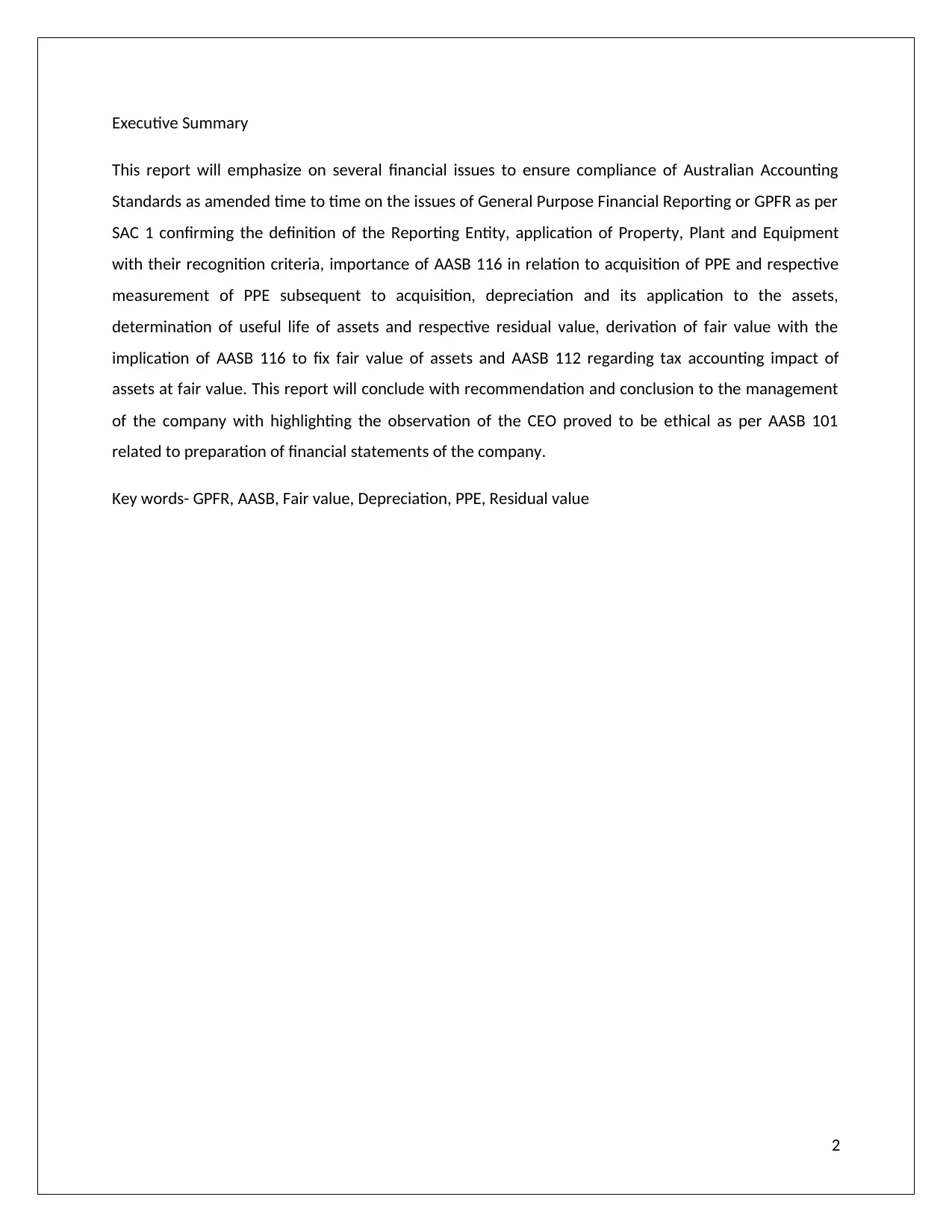
Executive Summary
This report will emphasize on several financial issues to ensure compliance of Australian Accounting
Standards as amended time to time on the issues of General Purpose Financial Reporting or GPFR as per
SAC 1 confirming the definition of the Reporting Entity, application of Property, Plant and Equipment
with their recognition criteria, importance of AASB 116 in relation to acquisition of PPE and respective
measurement of PPE subsequent to acquisition, depreciation and its application to the assets,
determination of useful life of assets and respective residual value, derivation of fair value with the
implication of AASB 116 to fix fair value of assets and AASB 112 regarding tax accounting impact of
assets at fair value. This report will conclude with recommendation and conclusion to the management
of the company with highlighting the observation of the CEO proved to be ethical as per AASB 101
related to preparation of financial statements of the company.
Key words- GPFR, AASB, Fair value, Depreciation, PPE, Residual value
2
This report will emphasize on several financial issues to ensure compliance of Australian Accounting
Standards as amended time to time on the issues of General Purpose Financial Reporting or GPFR as per
SAC 1 confirming the definition of the Reporting Entity, application of Property, Plant and Equipment
with their recognition criteria, importance of AASB 116 in relation to acquisition of PPE and respective
measurement of PPE subsequent to acquisition, depreciation and its application to the assets,
determination of useful life of assets and respective residual value, derivation of fair value with the
implication of AASB 116 to fix fair value of assets and AASB 112 regarding tax accounting impact of
assets at fair value. This report will conclude with recommendation and conclusion to the management
of the company with highlighting the observation of the CEO proved to be ethical as per AASB 101
related to preparation of financial statements of the company.
Key words- GPFR, AASB, Fair value, Depreciation, PPE, Residual value
2
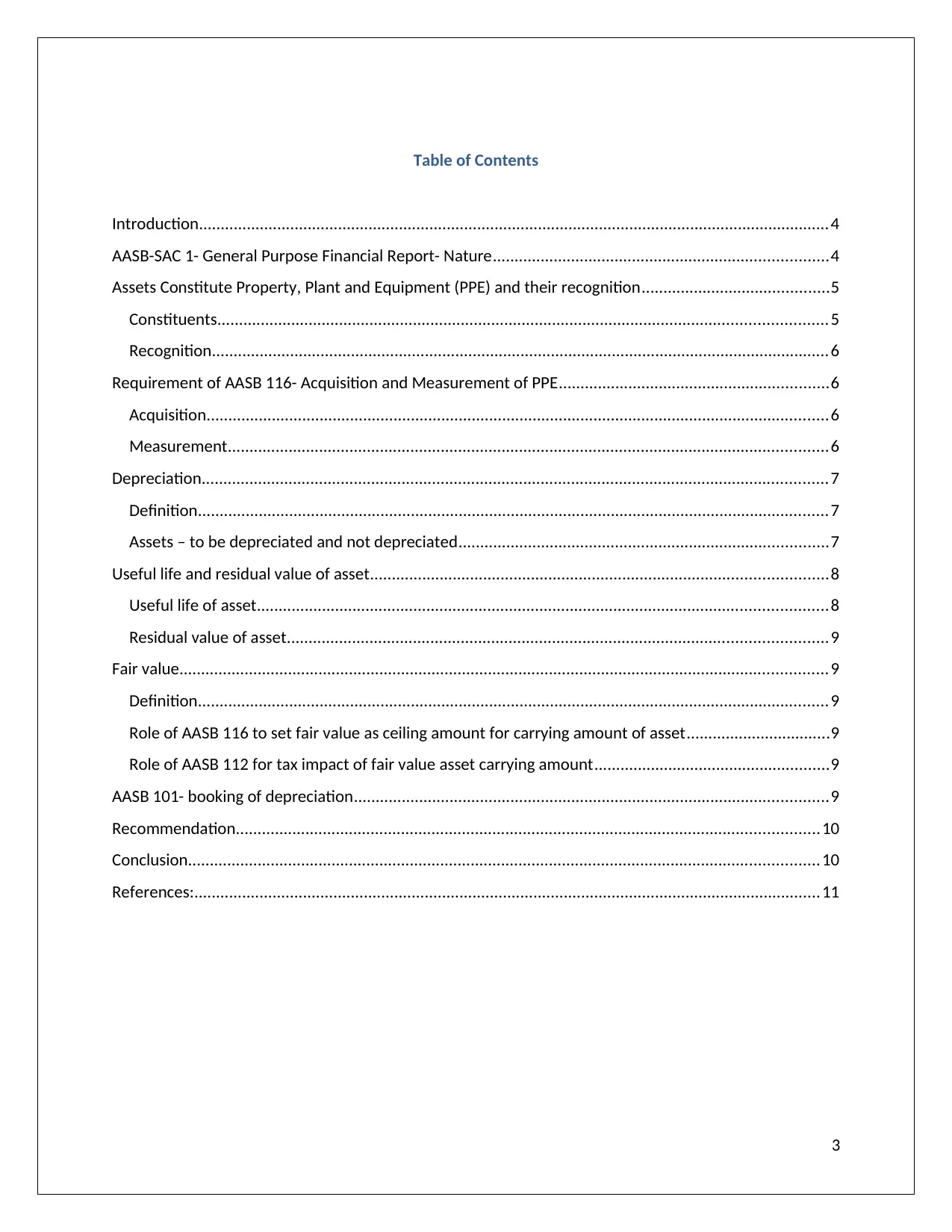
Table of Contents
Introduction.................................................................................................................................................4
AASB-SAC 1- General Purpose Financial Report- Nature.............................................................................4
Assets Constitute Property, Plant and Equipment (PPE) and their recognition...........................................5
Constituents............................................................................................................................................5
Recognition..............................................................................................................................................6
Requirement of AASB 116- Acquisition and Measurement of PPE..............................................................6
Acquisition...............................................................................................................................................6
Measurement..........................................................................................................................................6
Depreciation................................................................................................................................................7
Definition.................................................................................................................................................7
Assets – to be depreciated and not depreciated.....................................................................................7
Useful life and residual value of asset.........................................................................................................8
Useful life of asset...................................................................................................................................8
Residual value of asset............................................................................................................................9
Fair value.....................................................................................................................................................9
Definition.................................................................................................................................................9
Role of AASB 116 to set fair value as ceiling amount for carrying amount of asset.................................9
Role of AASB 112 for tax impact of fair value asset carrying amount......................................................9
AASB 101- booking of depreciation.............................................................................................................9
Recommendation......................................................................................................................................10
Conclusion.................................................................................................................................................10
References:................................................................................................................................................11
3
Introduction.................................................................................................................................................4
AASB-SAC 1- General Purpose Financial Report- Nature.............................................................................4
Assets Constitute Property, Plant and Equipment (PPE) and their recognition...........................................5
Constituents............................................................................................................................................5
Recognition..............................................................................................................................................6
Requirement of AASB 116- Acquisition and Measurement of PPE..............................................................6
Acquisition...............................................................................................................................................6
Measurement..........................................................................................................................................6
Depreciation................................................................................................................................................7
Definition.................................................................................................................................................7
Assets – to be depreciated and not depreciated.....................................................................................7
Useful life and residual value of asset.........................................................................................................8
Useful life of asset...................................................................................................................................8
Residual value of asset............................................................................................................................9
Fair value.....................................................................................................................................................9
Definition.................................................................................................................................................9
Role of AASB 116 to set fair value as ceiling amount for carrying amount of asset.................................9
Role of AASB 112 for tax impact of fair value asset carrying amount......................................................9
AASB 101- booking of depreciation.............................................................................................................9
Recommendation......................................................................................................................................10
Conclusion.................................................................................................................................................10
References:................................................................................................................................................11
3
⊘ This is a preview!⊘
Do you want full access?
Subscribe today to unlock all pages.

Trusted by 1+ million students worldwide
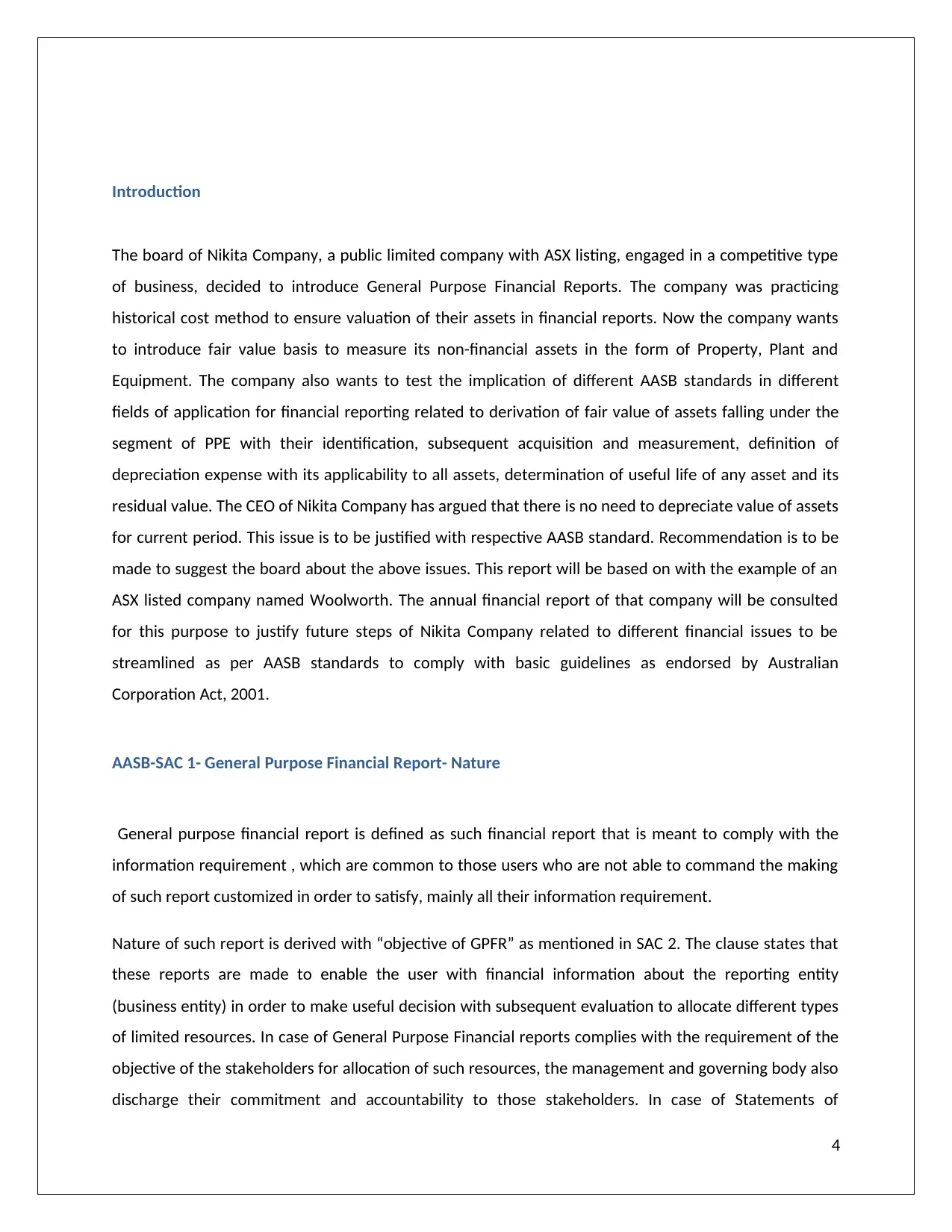
Introduction
The board of Nikita Company, a public limited company with ASX listing, engaged in a competitive type
of business, decided to introduce General Purpose Financial Reports. The company was practicing
historical cost method to ensure valuation of their assets in financial reports. Now the company wants
to introduce fair value basis to measure its non-financial assets in the form of Property, Plant and
Equipment. The company also wants to test the implication of different AASB standards in different
fields of application for financial reporting related to derivation of fair value of assets falling under the
segment of PPE with their identification, subsequent acquisition and measurement, definition of
depreciation expense with its applicability to all assets, determination of useful life of any asset and its
residual value. The CEO of Nikita Company has argued that there is no need to depreciate value of assets
for current period. This issue is to be justified with respective AASB standard. Recommendation is to be
made to suggest the board about the above issues. This report will be based on with the example of an
ASX listed company named Woolworth. The annual financial report of that company will be consulted
for this purpose to justify future steps of Nikita Company related to different financial issues to be
streamlined as per AASB standards to comply with basic guidelines as endorsed by Australian
Corporation Act, 2001.
AASB-SAC 1- General Purpose Financial Report- Nature
General purpose financial report is defined as such financial report that is meant to comply with the
information requirement , which are common to those users who are not able to command the making
of such report customized in order to satisfy, mainly all their information requirement.
Nature of such report is derived with “objective of GPFR” as mentioned in SAC 2. The clause states that
these reports are made to enable the user with financial information about the reporting entity
(business entity) in order to make useful decision with subsequent evaluation to allocate different types
of limited resources. In case of General Purpose Financial reports complies with the requirement of the
objective of the stakeholders for allocation of such resources, the management and governing body also
discharge their commitment and accountability to those stakeholders. In case of Statements of
4
The board of Nikita Company, a public limited company with ASX listing, engaged in a competitive type
of business, decided to introduce General Purpose Financial Reports. The company was practicing
historical cost method to ensure valuation of their assets in financial reports. Now the company wants
to introduce fair value basis to measure its non-financial assets in the form of Property, Plant and
Equipment. The company also wants to test the implication of different AASB standards in different
fields of application for financial reporting related to derivation of fair value of assets falling under the
segment of PPE with their identification, subsequent acquisition and measurement, definition of
depreciation expense with its applicability to all assets, determination of useful life of any asset and its
residual value. The CEO of Nikita Company has argued that there is no need to depreciate value of assets
for current period. This issue is to be justified with respective AASB standard. Recommendation is to be
made to suggest the board about the above issues. This report will be based on with the example of an
ASX listed company named Woolworth. The annual financial report of that company will be consulted
for this purpose to justify future steps of Nikita Company related to different financial issues to be
streamlined as per AASB standards to comply with basic guidelines as endorsed by Australian
Corporation Act, 2001.
AASB-SAC 1- General Purpose Financial Report- Nature
General purpose financial report is defined as such financial report that is meant to comply with the
information requirement , which are common to those users who are not able to command the making
of such report customized in order to satisfy, mainly all their information requirement.
Nature of such report is derived with “objective of GPFR” as mentioned in SAC 2. The clause states that
these reports are made to enable the user with financial information about the reporting entity
(business entity) in order to make useful decision with subsequent evaluation to allocate different types
of limited resources. In case of General Purpose Financial reports complies with the requirement of the
objective of the stakeholders for allocation of such resources, the management and governing body also
discharge their commitment and accountability to those stakeholders. In case of Statements of
4
Paraphrase This Document
Need a fresh take? Get an instant paraphrase of this document with our AI Paraphraser
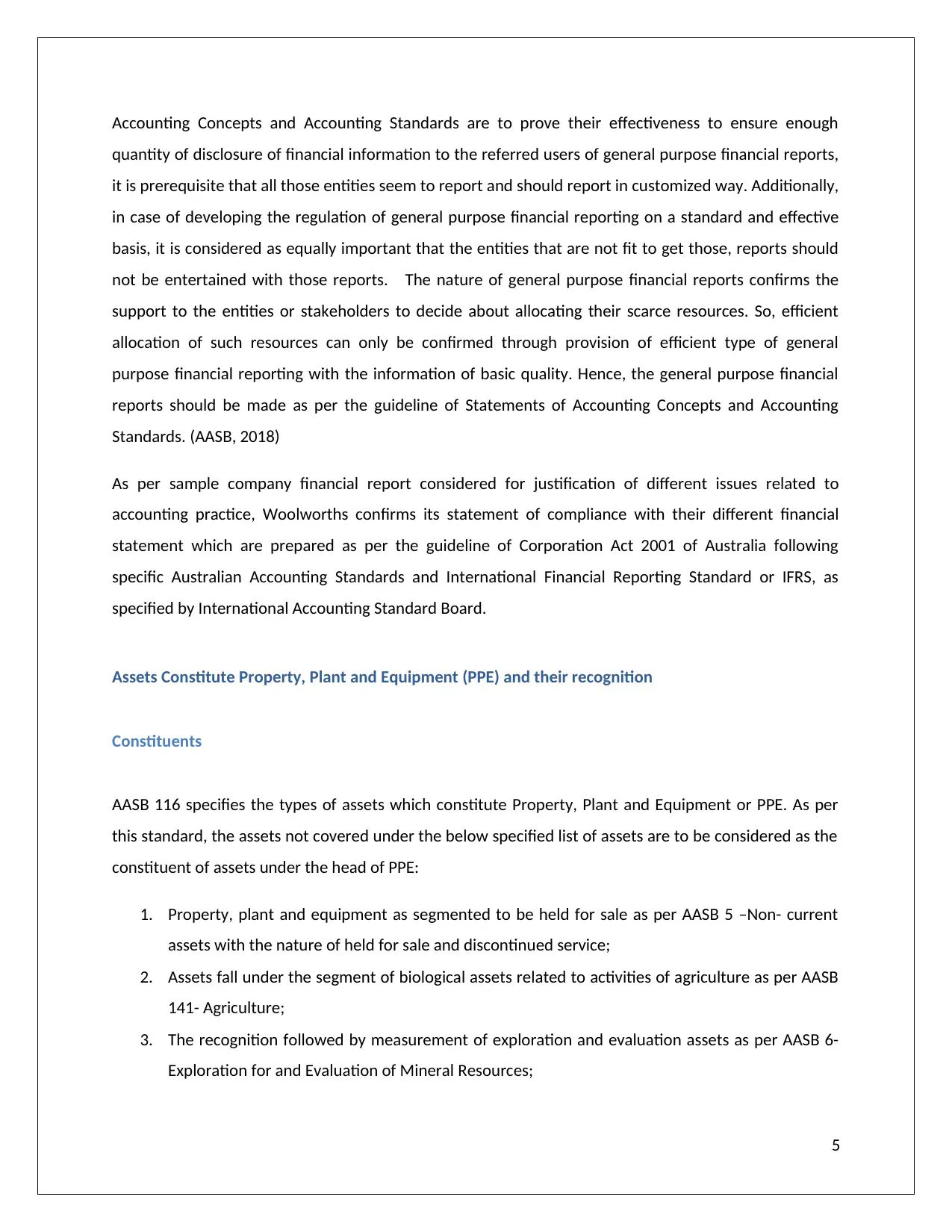
Accounting Concepts and Accounting Standards are to prove their effectiveness to ensure enough
quantity of disclosure of financial information to the referred users of general purpose financial reports,
it is prerequisite that all those entities seem to report and should report in customized way. Additionally,
in case of developing the regulation of general purpose financial reporting on a standard and effective
basis, it is considered as equally important that the entities that are not fit to get those, reports should
not be entertained with those reports. The nature of general purpose financial reports confirms the
support to the entities or stakeholders to decide about allocating their scarce resources. So, efficient
allocation of such resources can only be confirmed through provision of efficient type of general
purpose financial reporting with the information of basic quality. Hence, the general purpose financial
reports should be made as per the guideline of Statements of Accounting Concepts and Accounting
Standards. (AASB, 2018)
As per sample company financial report considered for justification of different issues related to
accounting practice, Woolworths confirms its statement of compliance with their different financial
statement which are prepared as per the guideline of Corporation Act 2001 of Australia following
specific Australian Accounting Standards and International Financial Reporting Standard or IFRS, as
specified by International Accounting Standard Board.
Assets Constitute Property, Plant and Equipment (PPE) and their recognition
Constituents
AASB 116 specifies the types of assets which constitute Property, Plant and Equipment or PPE. As per
this standard, the assets not covered under the below specified list of assets are to be considered as the
constituent of assets under the head of PPE:
1. Property, plant and equipment as segmented to be held for sale as per AASB 5 –Non- current
assets with the nature of held for sale and discontinued service;
2. Assets fall under the segment of biological assets related to activities of agriculture as per AASB
141- Agriculture;
3. The recognition followed by measurement of exploration and evaluation assets as per AASB 6-
Exploration for and Evaluation of Mineral Resources;
5
quantity of disclosure of financial information to the referred users of general purpose financial reports,
it is prerequisite that all those entities seem to report and should report in customized way. Additionally,
in case of developing the regulation of general purpose financial reporting on a standard and effective
basis, it is considered as equally important that the entities that are not fit to get those, reports should
not be entertained with those reports. The nature of general purpose financial reports confirms the
support to the entities or stakeholders to decide about allocating their scarce resources. So, efficient
allocation of such resources can only be confirmed through provision of efficient type of general
purpose financial reporting with the information of basic quality. Hence, the general purpose financial
reports should be made as per the guideline of Statements of Accounting Concepts and Accounting
Standards. (AASB, 2018)
As per sample company financial report considered for justification of different issues related to
accounting practice, Woolworths confirms its statement of compliance with their different financial
statement which are prepared as per the guideline of Corporation Act 2001 of Australia following
specific Australian Accounting Standards and International Financial Reporting Standard or IFRS, as
specified by International Accounting Standard Board.
Assets Constitute Property, Plant and Equipment (PPE) and their recognition
Constituents
AASB 116 specifies the types of assets which constitute Property, Plant and Equipment or PPE. As per
this standard, the assets not covered under the below specified list of assets are to be considered as the
constituent of assets under the head of PPE:
1. Property, plant and equipment as segmented to be held for sale as per AASB 5 –Non- current
assets with the nature of held for sale and discontinued service;
2. Assets fall under the segment of biological assets related to activities of agriculture as per AASB
141- Agriculture;
3. The recognition followed by measurement of exploration and evaluation assets as per AASB 6-
Exploration for and Evaluation of Mineral Resources;
5
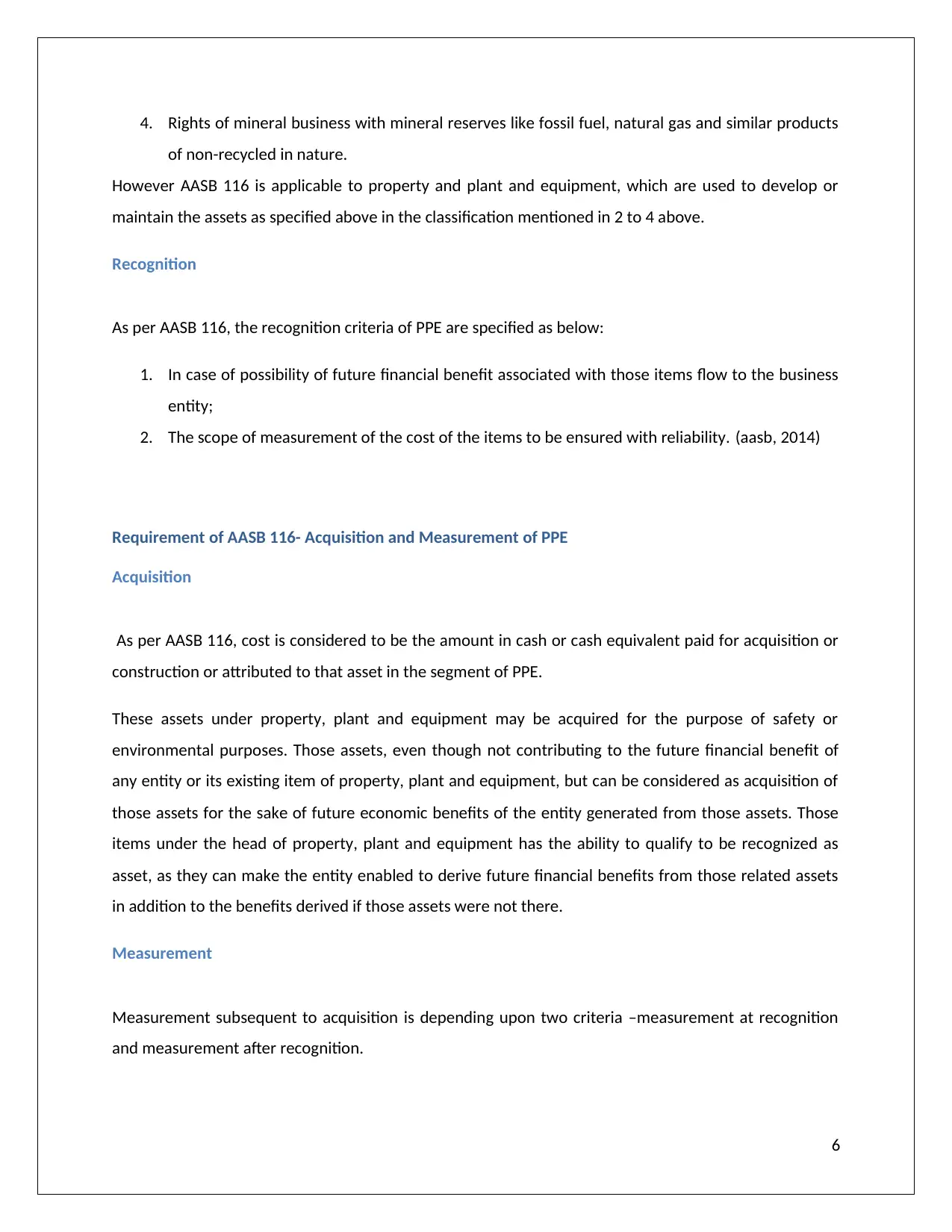
4. Rights of mineral business with mineral reserves like fossil fuel, natural gas and similar products
of non-recycled in nature.
However AASB 116 is applicable to property and plant and equipment, which are used to develop or
maintain the assets as specified above in the classification mentioned in 2 to 4 above.
Recognition
As per AASB 116, the recognition criteria of PPE are specified as below:
1. In case of possibility of future financial benefit associated with those items flow to the business
entity;
2. The scope of measurement of the cost of the items to be ensured with reliability. (aasb, 2014)
Requirement of AASB 116- Acquisition and Measurement of PPE
Acquisition
As per AASB 116, cost is considered to be the amount in cash or cash equivalent paid for acquisition or
construction or attributed to that asset in the segment of PPE.
These assets under property, plant and equipment may be acquired for the purpose of safety or
environmental purposes. Those assets, even though not contributing to the future financial benefit of
any entity or its existing item of property, plant and equipment, but can be considered as acquisition of
those assets for the sake of future economic benefits of the entity generated from those assets. Those
items under the head of property, plant and equipment has the ability to qualify to be recognized as
asset, as they can make the entity enabled to derive future financial benefits from those related assets
in addition to the benefits derived if those assets were not there.
Measurement
Measurement subsequent to acquisition is depending upon two criteria –measurement at recognition
and measurement after recognition.
6
of non-recycled in nature.
However AASB 116 is applicable to property and plant and equipment, which are used to develop or
maintain the assets as specified above in the classification mentioned in 2 to 4 above.
Recognition
As per AASB 116, the recognition criteria of PPE are specified as below:
1. In case of possibility of future financial benefit associated with those items flow to the business
entity;
2. The scope of measurement of the cost of the items to be ensured with reliability. (aasb, 2014)
Requirement of AASB 116- Acquisition and Measurement of PPE
Acquisition
As per AASB 116, cost is considered to be the amount in cash or cash equivalent paid for acquisition or
construction or attributed to that asset in the segment of PPE.
These assets under property, plant and equipment may be acquired for the purpose of safety or
environmental purposes. Those assets, even though not contributing to the future financial benefit of
any entity or its existing item of property, plant and equipment, but can be considered as acquisition of
those assets for the sake of future economic benefits of the entity generated from those assets. Those
items under the head of property, plant and equipment has the ability to qualify to be recognized as
asset, as they can make the entity enabled to derive future financial benefits from those related assets
in addition to the benefits derived if those assets were not there.
Measurement
Measurement subsequent to acquisition is depending upon two criteria –measurement at recognition
and measurement after recognition.
6
⊘ This is a preview!⊘
Do you want full access?
Subscribe today to unlock all pages.

Trusted by 1+ million students worldwide
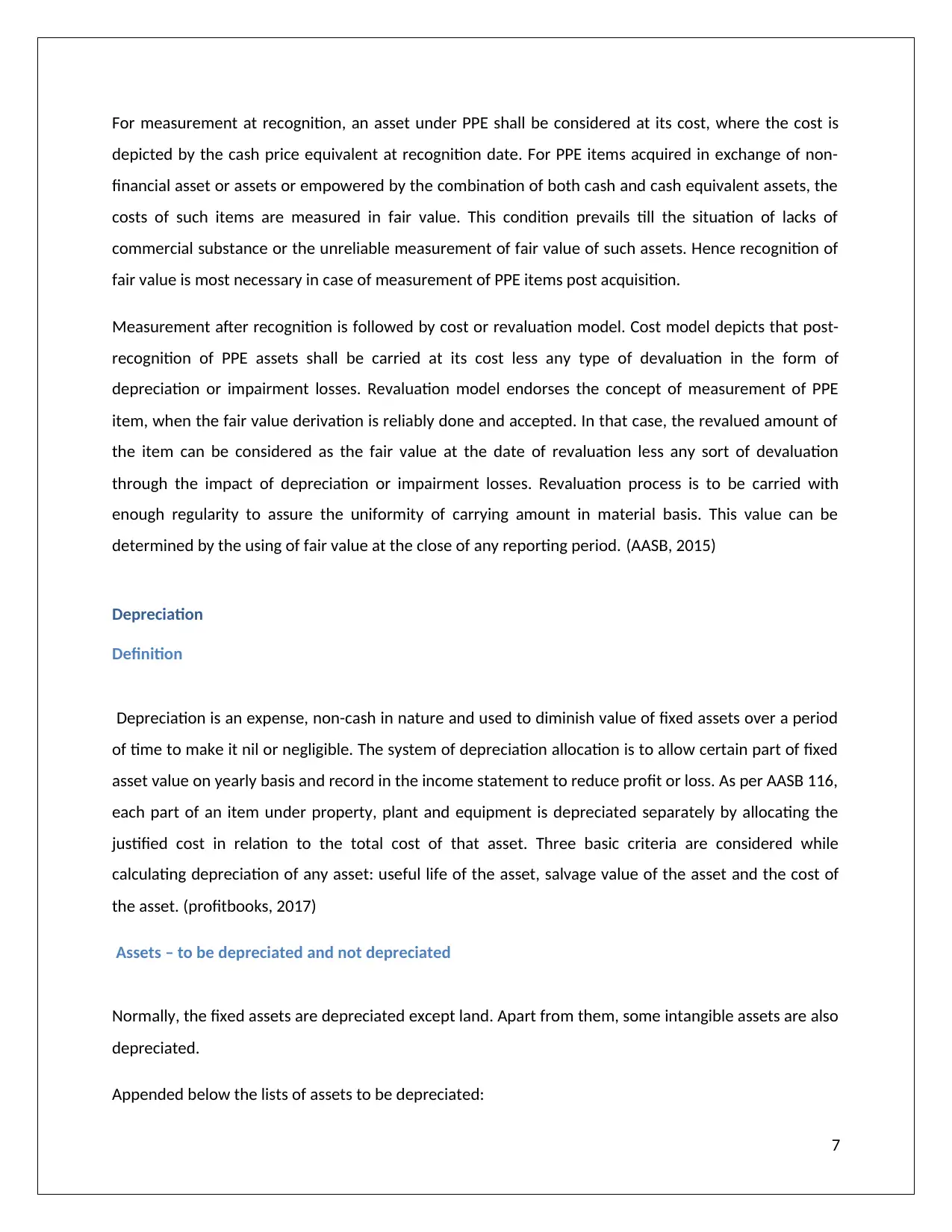
For measurement at recognition, an asset under PPE shall be considered at its cost, where the cost is
depicted by the cash price equivalent at recognition date. For PPE items acquired in exchange of non-
financial asset or assets or empowered by the combination of both cash and cash equivalent assets, the
costs of such items are measured in fair value. This condition prevails till the situation of lacks of
commercial substance or the unreliable measurement of fair value of such assets. Hence recognition of
fair value is most necessary in case of measurement of PPE items post acquisition.
Measurement after recognition is followed by cost or revaluation model. Cost model depicts that post-
recognition of PPE assets shall be carried at its cost less any type of devaluation in the form of
depreciation or impairment losses. Revaluation model endorses the concept of measurement of PPE
item, when the fair value derivation is reliably done and accepted. In that case, the revalued amount of
the item can be considered as the fair value at the date of revaluation less any sort of devaluation
through the impact of depreciation or impairment losses. Revaluation process is to be carried with
enough regularity to assure the uniformity of carrying amount in material basis. This value can be
determined by the using of fair value at the close of any reporting period. (AASB, 2015)
Depreciation
Definition
Depreciation is an expense, non-cash in nature and used to diminish value of fixed assets over a period
of time to make it nil or negligible. The system of depreciation allocation is to allow certain part of fixed
asset value on yearly basis and record in the income statement to reduce profit or loss. As per AASB 116,
each part of an item under property, plant and equipment is depreciated separately by allocating the
justified cost in relation to the total cost of that asset. Three basic criteria are considered while
calculating depreciation of any asset: useful life of the asset, salvage value of the asset and the cost of
the asset. (profitbooks, 2017)
Assets – to be depreciated and not depreciated
Normally, the fixed assets are depreciated except land. Apart from them, some intangible assets are also
depreciated.
Appended below the lists of assets to be depreciated:
7
depicted by the cash price equivalent at recognition date. For PPE items acquired in exchange of non-
financial asset or assets or empowered by the combination of both cash and cash equivalent assets, the
costs of such items are measured in fair value. This condition prevails till the situation of lacks of
commercial substance or the unreliable measurement of fair value of such assets. Hence recognition of
fair value is most necessary in case of measurement of PPE items post acquisition.
Measurement after recognition is followed by cost or revaluation model. Cost model depicts that post-
recognition of PPE assets shall be carried at its cost less any type of devaluation in the form of
depreciation or impairment losses. Revaluation model endorses the concept of measurement of PPE
item, when the fair value derivation is reliably done and accepted. In that case, the revalued amount of
the item can be considered as the fair value at the date of revaluation less any sort of devaluation
through the impact of depreciation or impairment losses. Revaluation process is to be carried with
enough regularity to assure the uniformity of carrying amount in material basis. This value can be
determined by the using of fair value at the close of any reporting period. (AASB, 2015)
Depreciation
Definition
Depreciation is an expense, non-cash in nature and used to diminish value of fixed assets over a period
of time to make it nil or negligible. The system of depreciation allocation is to allow certain part of fixed
asset value on yearly basis and record in the income statement to reduce profit or loss. As per AASB 116,
each part of an item under property, plant and equipment is depreciated separately by allocating the
justified cost in relation to the total cost of that asset. Three basic criteria are considered while
calculating depreciation of any asset: useful life of the asset, salvage value of the asset and the cost of
the asset. (profitbooks, 2017)
Assets – to be depreciated and not depreciated
Normally, the fixed assets are depreciated except land. Apart from them, some intangible assets are also
depreciated.
Appended below the lists of assets to be depreciated:
7
Paraphrase This Document
Need a fresh take? Get an instant paraphrase of this document with our AI Paraphraser
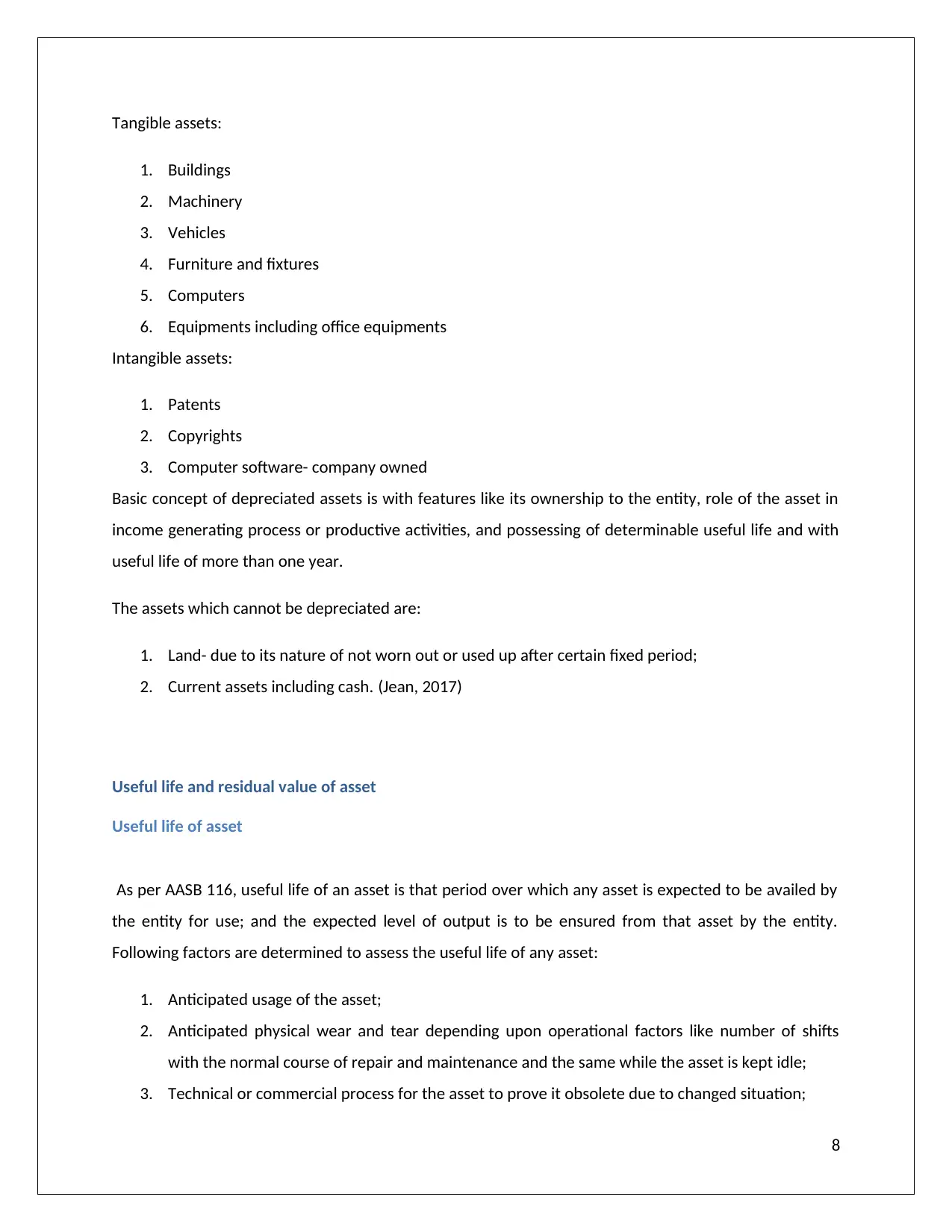
Tangible assets:
1. Buildings
2. Machinery
3. Vehicles
4. Furniture and fixtures
5. Computers
6. Equipments including office equipments
Intangible assets:
1. Patents
2. Copyrights
3. Computer software- company owned
Basic concept of depreciated assets is with features like its ownership to the entity, role of the asset in
income generating process or productive activities, and possessing of determinable useful life and with
useful life of more than one year.
The assets which cannot be depreciated are:
1. Land- due to its nature of not worn out or used up after certain fixed period;
2. Current assets including cash. (Jean, 2017)
Useful life and residual value of asset
Useful life of asset
As per AASB 116, useful life of an asset is that period over which any asset is expected to be availed by
the entity for use; and the expected level of output is to be ensured from that asset by the entity.
Following factors are determined to assess the useful life of any asset:
1. Anticipated usage of the asset;
2. Anticipated physical wear and tear depending upon operational factors like number of shifts
with the normal course of repair and maintenance and the same while the asset is kept idle;
3. Technical or commercial process for the asset to prove it obsolete due to changed situation;
8
1. Buildings
2. Machinery
3. Vehicles
4. Furniture and fixtures
5. Computers
6. Equipments including office equipments
Intangible assets:
1. Patents
2. Copyrights
3. Computer software- company owned
Basic concept of depreciated assets is with features like its ownership to the entity, role of the asset in
income generating process or productive activities, and possessing of determinable useful life and with
useful life of more than one year.
The assets which cannot be depreciated are:
1. Land- due to its nature of not worn out or used up after certain fixed period;
2. Current assets including cash. (Jean, 2017)
Useful life and residual value of asset
Useful life of asset
As per AASB 116, useful life of an asset is that period over which any asset is expected to be availed by
the entity for use; and the expected level of output is to be ensured from that asset by the entity.
Following factors are determined to assess the useful life of any asset:
1. Anticipated usage of the asset;
2. Anticipated physical wear and tear depending upon operational factors like number of shifts
with the normal course of repair and maintenance and the same while the asset is kept idle;
3. Technical or commercial process for the asset to prove it obsolete due to changed situation;
8
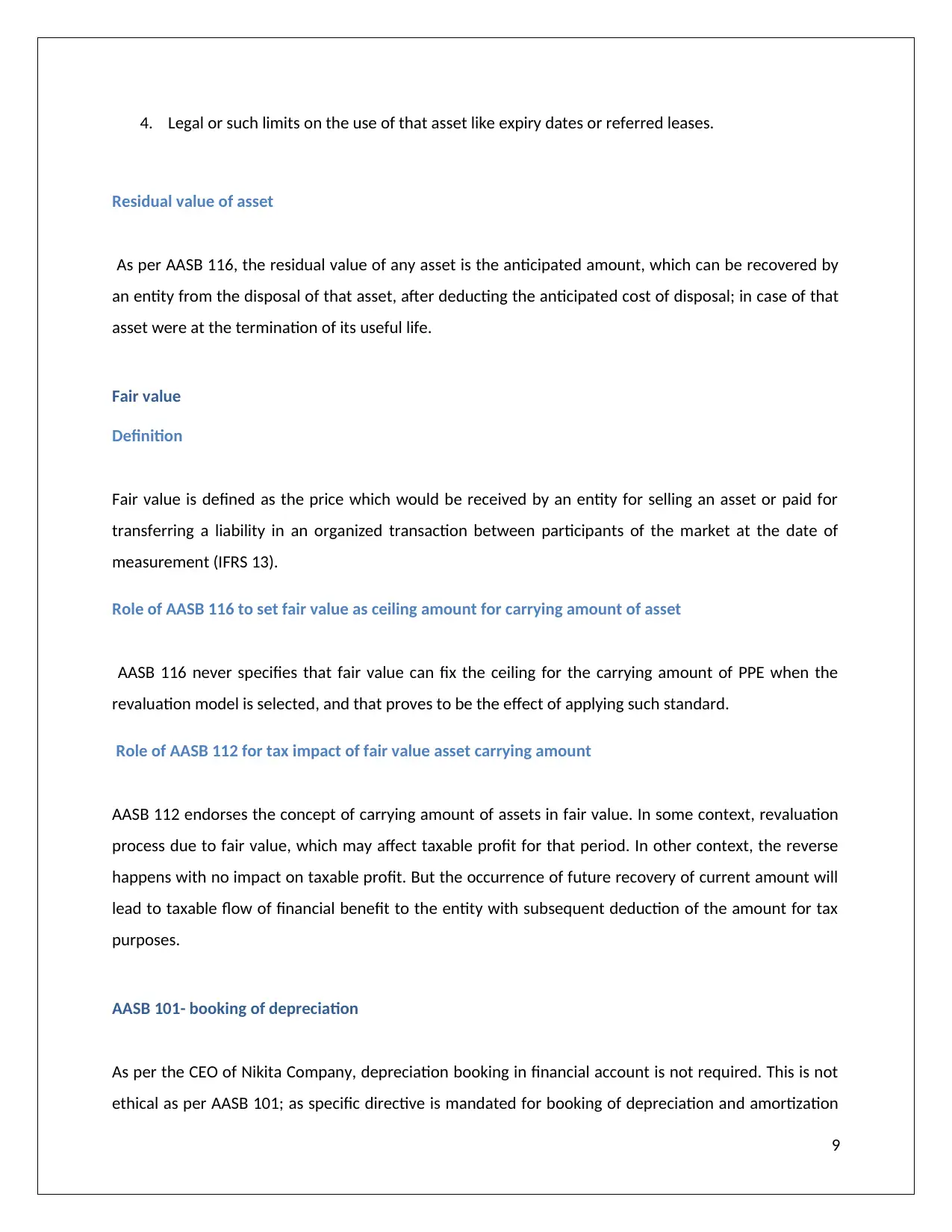
4. Legal or such limits on the use of that asset like expiry dates or referred leases.
Residual value of asset
As per AASB 116, the residual value of any asset is the anticipated amount, which can be recovered by
an entity from the disposal of that asset, after deducting the anticipated cost of disposal; in case of that
asset were at the termination of its useful life.
Fair value
Definition
Fair value is defined as the price which would be received by an entity for selling an asset or paid for
transferring a liability in an organized transaction between participants of the market at the date of
measurement (IFRS 13).
Role of AASB 116 to set fair value as ceiling amount for carrying amount of asset
AASB 116 never specifies that fair value can fix the ceiling for the carrying amount of PPE when the
revaluation model is selected, and that proves to be the effect of applying such standard.
Role of AASB 112 for tax impact of fair value asset carrying amount
AASB 112 endorses the concept of carrying amount of assets in fair value. In some context, revaluation
process due to fair value, which may affect taxable profit for that period. In other context, the reverse
happens with no impact on taxable profit. But the occurrence of future recovery of current amount will
lead to taxable flow of financial benefit to the entity with subsequent deduction of the amount for tax
purposes.
AASB 101- booking of depreciation
As per the CEO of Nikita Company, depreciation booking in financial account is not required. This is not
ethical as per AASB 101; as specific directive is mandated for booking of depreciation and amortization
9
Residual value of asset
As per AASB 116, the residual value of any asset is the anticipated amount, which can be recovered by
an entity from the disposal of that asset, after deducting the anticipated cost of disposal; in case of that
asset were at the termination of its useful life.
Fair value
Definition
Fair value is defined as the price which would be received by an entity for selling an asset or paid for
transferring a liability in an organized transaction between participants of the market at the date of
measurement (IFRS 13).
Role of AASB 116 to set fair value as ceiling amount for carrying amount of asset
AASB 116 never specifies that fair value can fix the ceiling for the carrying amount of PPE when the
revaluation model is selected, and that proves to be the effect of applying such standard.
Role of AASB 112 for tax impact of fair value asset carrying amount
AASB 112 endorses the concept of carrying amount of assets in fair value. In some context, revaluation
process due to fair value, which may affect taxable profit for that period. In other context, the reverse
happens with no impact on taxable profit. But the occurrence of future recovery of current amount will
lead to taxable flow of financial benefit to the entity with subsequent deduction of the amount for tax
purposes.
AASB 101- booking of depreciation
As per the CEO of Nikita Company, depreciation booking in financial account is not required. This is not
ethical as per AASB 101; as specific directive is mandated for booking of depreciation and amortization
9
⊘ This is a preview!⊘
Do you want full access?
Subscribe today to unlock all pages.

Trusted by 1+ million students worldwide

in the financial statement of profit or loss and other comprehensive income statement of any public
limited company.
Recommendation
To ensure proper maintenance of accounts with prudence and satisfaction to the external stakeholders,
AASB standards are to be followed with diligence. This is the statutory compliance expected from the
companies of ASX listing. AASB 116 is to be understood with proper accounting treatment to be
featured in financial statements for maintaining records of assets falling under PPE.
AASB 101 is to be strictly followed for preparation and presentation of financial statements to the
stakeholders with no scope for personal justification to consider or ignore any item.
Conclusion
The company has started to implement the practice of AASB with emphasis on asset accounting
management ensuring proper treatment of fair value derivation, impairment process of assets and by
featuring the same in their financial statements. It is to be ensured that proper understanding of the
directive of AASB related to respective areas should be done followed by right compliance as per
guideline fixed by the authority. The company CEO had urged for non-allocation of depreciation in the
annual financial report, which is not ethically permitted by AASB. Being a public limited company, the
company has certain obligations there so far financial reporting is concerned. The same is to be adhered
to and complied with diligence for the sake of stakeholders.
10
limited company.
Recommendation
To ensure proper maintenance of accounts with prudence and satisfaction to the external stakeholders,
AASB standards are to be followed with diligence. This is the statutory compliance expected from the
companies of ASX listing. AASB 116 is to be understood with proper accounting treatment to be
featured in financial statements for maintaining records of assets falling under PPE.
AASB 101 is to be strictly followed for preparation and presentation of financial statements to the
stakeholders with no scope for personal justification to consider or ignore any item.
Conclusion
The company has started to implement the practice of AASB with emphasis on asset accounting
management ensuring proper treatment of fair value derivation, impairment process of assets and by
featuring the same in their financial statements. It is to be ensured that proper understanding of the
directive of AASB related to respective areas should be done followed by right compliance as per
guideline fixed by the authority. The company CEO had urged for non-allocation of depreciation in the
annual financial report, which is not ethically permitted by AASB. Being a public limited company, the
company has certain obligations there so far financial reporting is concerned. The same is to be adhered
to and complied with diligence for the sake of stakeholders.
10
Paraphrase This Document
Need a fresh take? Get an instant paraphrase of this document with our AI Paraphraser
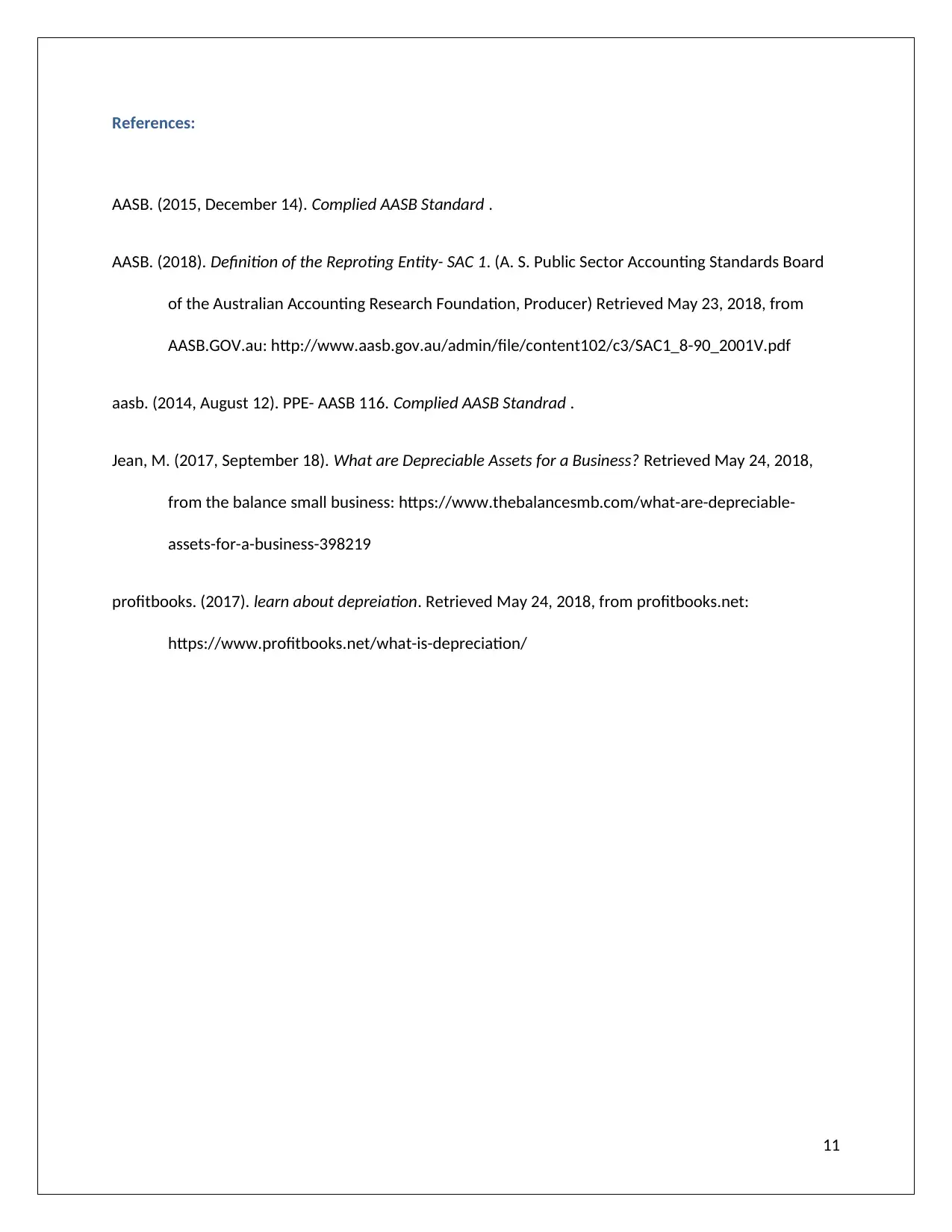
References:
AASB. (2015, December 14). Complied AASB Standard .
AASB. (2018). Definition of the Reproting Entity- SAC 1. (A. S. Public Sector Accounting Standards Board
of the Australian Accounting Research Foundation, Producer) Retrieved May 23, 2018, from
AASB.GOV.au: http://www.aasb.gov.au/admin/file/content102/c3/SAC1_8-90_2001V.pdf
aasb. (2014, August 12). PPE- AASB 116. Complied AASB Standrad .
Jean, M. (2017, September 18). What are Depreciable Assets for a Business? Retrieved May 24, 2018,
from the balance small business: https://www.thebalancesmb.com/what-are-depreciable-
assets-for-a-business-398219
profitbooks. (2017). learn about depreiation. Retrieved May 24, 2018, from profitbooks.net:
https://www.profitbooks.net/what-is-depreciation/
11
AASB. (2015, December 14). Complied AASB Standard .
AASB. (2018). Definition of the Reproting Entity- SAC 1. (A. S. Public Sector Accounting Standards Board
of the Australian Accounting Research Foundation, Producer) Retrieved May 23, 2018, from
AASB.GOV.au: http://www.aasb.gov.au/admin/file/content102/c3/SAC1_8-90_2001V.pdf
aasb. (2014, August 12). PPE- AASB 116. Complied AASB Standrad .
Jean, M. (2017, September 18). What are Depreciable Assets for a Business? Retrieved May 24, 2018,
from the balance small business: https://www.thebalancesmb.com/what-are-depreciable-
assets-for-a-business-398219
profitbooks. (2017). learn about depreiation. Retrieved May 24, 2018, from profitbooks.net:
https://www.profitbooks.net/what-is-depreciation/
11
1 out of 11